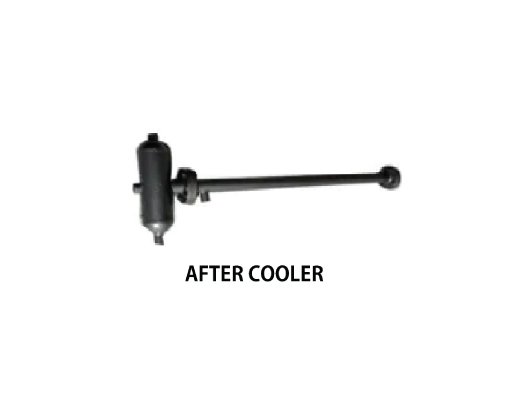-
Call
-
Whatsapp
9825014048
-
Location


After Cooler
After Cooler
Compressed air is the lifeblood of many industries, powering critical equipment and manufacturing processes. However, the compression process can improve compressed air quality, increasing temperature and humidity. This is where aftercoolers come into play.In this article, we’ll delve into the world of aftercoolers, exploring their functions, types, applications and critical roles in ensuring an efficient and reliable compressed air system.
An aftercooler, commonly called an intercooler, is a heat exchanger used in a compressed air system. Its primary function is to condense and densify hot and humid compressed air, reducing its temperature and humidity before it enters machinery or downward movements. Role of aftercoolers in compressed air systems.
The compressed air produced by the compressed air can reach higher temperatures due to the compression process.
These high temperatures can hurt the compressed air quality and the downstream equipment's performance and longevity.
Aftercoolers Address These Issues Through Several Mechanisms:
- Temperature reduction: The aftercooler reduces the temperature of the compressed air, preventing downstream equipment from overheating.
- Humidification: Through evaporation, post-cooling systems dilute the moisture content of the compressed air, preventing it from entering downstream channels.
- Improved quality: Aftercoolers help enhance the efficiency of compressed air, reducing the risk of spoilage, contamination and damage to equipment and processes.
- Energy efficiency: The compressed air is denser, resulting in more efficient and cost-effective downstream products and equipment.
Aftercoolers Address These Issues Through Several Mechanisms:
- Temperature reduction: The aftercooler reduces the temperature of the compressed air, preventing downstream equipment from overheating.
- Humidification: Through evaporation, post-cooling systems dilute the moisture content of the compressed air, preventing it from entering downstream channels.
- Improved quality: Aftercoolers help enhance the efficiency of compressed air, reducing the risk of spoilage, contamination and damage to equipment and processes.
- Energy efficiency: The compressed air is denser, resulting in more efficient and cost-effective downstream products and equipment.
Types of Aftercoolers
- Air cooling Aftercooling: This type of aftercooling uses ambient air to cool the compressed air. It is common in many industrial areas, as it does not require additional cooling water.
- Post-cooler Water Cooler: The cooler uses different types of water to cool the compressed air. They are generally preferred when the ambient temperature is high and additional cooling is required.
- Tube-in-Tube Aftercoolers: These aftercoolers have a unique arrangement with two tubes in the middle to allow cooling water to circulate an internal tube containing compressed air.
- Air cooling Aftercooling: This type of aftercooling uses ambient air to cool the compressed air. It is common in many industrial areas, as it does not require additional cooling water.
- Post-cooler Water Cooler: The cooler uses different types of water to cool the compressed air. They are generally preferred when the ambient temperature is high and additional cooling is required.
- Tube-in-tube Aftercoolers: These aftercoolers have a unique arrangement with two tubes in the middle to allow cooling water to circulate an internal tube containing compressed air Benefits of using an aftercooler.
- Equipment Protection: Post Cooling systems protect downstream equipment from the adverse effects of scorching and humid compressed air.
- Production Quality: In industries such as food processing and pharmaceuticals, post-processing processes maintain the purity and integrity of the final product.
- Energy Efficiency: Compressed air is denser and more efficient, resulting in lower energy consumption and operating costs.
- Environmental Compliance: Post-cooling systems help companies meet environmental standards by reducing emissions and preventing pollution.
- Health and Safety: Post-cooler systems contribute to a safe and healthy working environment by ensuring that compressed air meets specific quality and safety standards.


FAQ

Frequently Ask Questions
Aftercoolers can remove a great deal of moisture, but additional air purification equipment such as dryers may be required to completely remove condensation
In general, post-cooling water-cooled devices are more efficient at cooling compressed air, making them suitable for high-temperature environments.
Yes, by cooling and stabilizing the compressed air, postcooling devices help improve energy efficiency and reduce operating costs.
Yes, aftercoolers need to be inspected and maintained regularly to ensure they are working properly and effectively.
While not every system needs aftercoolers, they are especially useful in environments where high quality compressed air and durable equipment are needed

